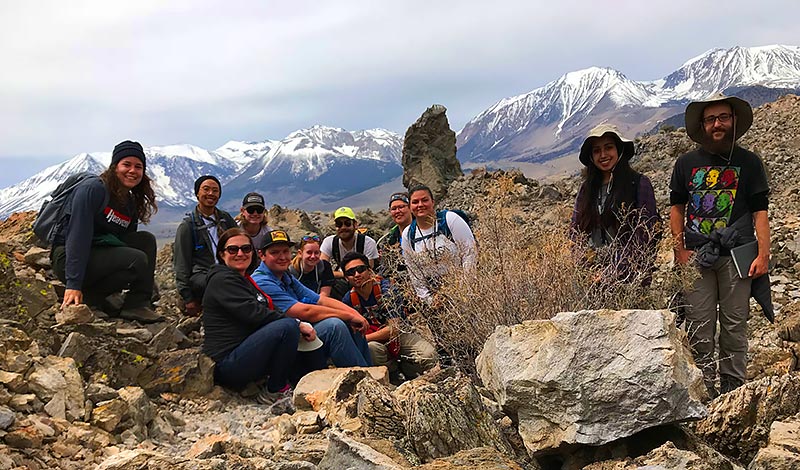
Unlike the spectacular — and catastrophic — volcano eruptions spewing dramatic hot lava flows in Hawaii and ash clouds and flows in Guatemala, Cal State Fullerton geologist Vali Memeti studies the magma plumbing systems of ancient volcanic eruptions like what is found in Yosemite National Park.
Memeti, assistant professor of geological sciences, and her students investigate the crystal growth rings of the crystals that once crystallized out of the hot magma— the molten rock beneath the Earth called lava at the surface — to find out how the magma environment changed over hundreds of thousands, and even millions, of years.
“With the chemical crystal ring record, we can interpret what was going on in the magma chambers of these systems,” she said. “This is where my work connects with both recent eruptions. Once the erupted materials can be touched and sampled, geochemists look at the rings of the crystals, and the quenched molten rock that turns into glass, to examine what might have caused these specific eruptions.”
This summer, Memeti’s students are doing fieldwork in Yosemite to study the crystals that formed from magmas. They’ll backpack into the wilderness with llamas to carry gear and rock samples. (See sidebar)
What’s your observation about the Kilauea and Volcán de Fuego eruptions?
When volcanic eruptions occur today, like the current lava-forming eruptions at Hawaii’s Kilauea, or the recent explosive Volcán de Fuego in Guatemala, we get excited because we can watch an active volcano do its thing. The Fuego eruption is much more explosive than Kilauea due to its stickier magma composition and higher volatile content, dramatically distributing ash — exploded magma — all over the place very quickly. The death toll with this eruption is likely going to increase. This is the kind of eruption we think occurred above the Yosemite magma chambers.
What’s it like to study volcanoes in the field?
It’s the best thing I can ever imagine doing! I am a petrologist and geochemist who studies the ancient magma reservoirs and plumbing of volcanoes now frozen into so-called plutons that are exposed at the surface as granite. Ancient volcanic eruptions have been catastrophic at the global scale and leave a lot of clues in the rock record as to what happened. I personally find this forensic work on rocks and minerals to be the most fun and rewarding aspect of our research.
What do you hope to learn about Yosemite?
My students and I are examining the magma plumbing of a chain of volcanoes that existed on top of the Sierra Nevada mountain range 250 to 65 million years ago. This is similar to the active chain of the Cascadia Range of more than 14 volcanoes reaching from Northern California to British Columbia. These include, for example, Mount St. Helens, Mount Rainier, Mount Lassen and Mount Shasta. The rocks in Yosemite represent magmas in a magma reservoir that once resided at depths of about 6 miles deep. We’re using geologic mapping and mineral chemistry to find out how large the Yosemite magma reservoir once was, how it changed its size over its 10 million years of activity and how much of that magma erupted versus how much was left behind to form plutonic rocks. While this system is not active, we like to do our research in Yosemite because the rocks are well exposed and the minerals are not altered by surface processes.
Are there active volcanoes in California?
Mount Shasta, Mount Lassen and Medicine Lake Volcano are considered to be active. Lassen last erupted about 100 years ago in 1915, and Shasta in 1786. These volcanoes could erupt in the future, but there are no indications that this might happen anytime soon. Other volcanically active areas include the Long Valley caldera between the towns of Bishop and Mammoth Lakes that erupted 760,000 years ago in a super-eruption. There is plenty of evidence for geothermal activity and small magnitude earthquakes related to magma movement, which indicates there is magma down there that could potentially make it out at some point.
What are some interesting facts about volcanoes?
Volcanic eruptions are a lot more common than most people think. There is about one volcanic eruption each week somewhere across the globe. Kilauea is the most active volcano on Earth. It has been erupting along its eastern rift zone since 1983 — not just since last month. You never know when an area might get active near a volcano. I’m sure the people living near the Kilauea volcano didn’t think that volcanic fissures would open up in their backyard anytime soon, despite living on an active volcano.